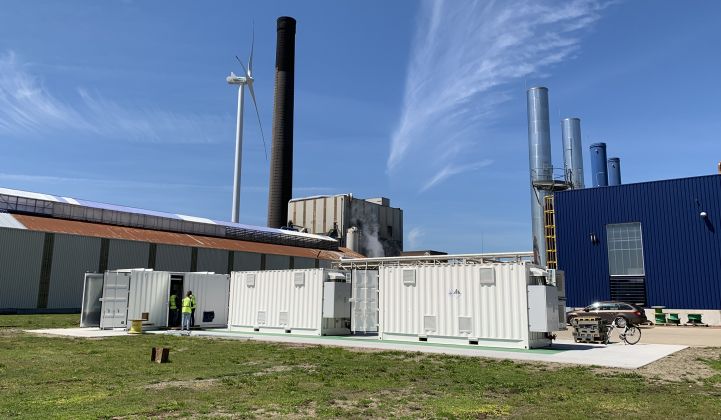Over the past decade, London-based Kiwi Power has harnessed a gigawatt of flexible commercial and industrial loads across 10 European countries into behind-the-meter networks of energy flexibility, capable of serving wholesale capacity markets, reducing strain on distribution grids and responding to second-by-second frequency regulation signals. More recently, it’s added 80 megawatts of behind-the-meter batteries to its virtual power plant portfolio.
On Tuesday Kiwi announced its first move into North America, starting with an ongoing project with investor Engie, the French energy giant that’s built a broad portfolio of North American battery, electric vehicle and C&I energy services.
Kiwi is working with Engie on a project to tap distributed energy resources (DERs) for price arbitrage in energy markets run by Texas grid operator ERCOT, where short-term price spikes can reach $9,000 per kilowatt-hour. These market dynamics are creating merchant opportunities for energy storage, but distributed energy has so far struggled to overcome market barriers.
“On a high level, we’re adding up load, and we’re enabling that load that could be on an index-linked contract to reach to surprise situations,” Stephan Marty, Kiwi's chief commercial officer, said in an interview. Although he wouldn’t provide many more commercial details, citing the competitive nature of Texas energy markets, he said, “You can think of it as an insurance policy for high prices.”
At the same time, Kiwi and Engie will be looking for opportunities to use the same behind-the-meter assets to serve ERCOT’s ancillary services markets, such as its emergency response services market. “Our technology platform enables us to do both — and we have the possibility to do one thing at one point in time and another thing at another point in time.”
Engie operates significant behind-the-meter battery fleets through its Engie Storage unit (formerly Green Charge Networks); it is aggregating energy storage for wholesale markets in locales ranging from Massachusetts to California. But Engie isn’t Kiwi’s exclusive North American partner, Marty noted. It’s also open to licensing its technology to other energy services providers, DER aggregators and utilities.
One example of the latter approach is Kiwi’s work with Canadian public utility Lakeland Power. Beyond tapping DERs for distribution grid flexibility, the utility is working with Ontario province grid operator IESO on an effort to integrate behind-the-meter assets into wholesale market operations. “The application is a bit different, but it’s all built on the same technology platform.”
Europe's lead in integrating distributed energy resources
Kiwi is far from the only European company targeting distributed energy market opportunities in North America. Centrica Business Solutions, a subsidiary of U.K. utility Centrica, bought Belgian demand response and virtual power plant aggregator REstore Power in 2017 and has a broad suite of energy services for U.S. and Canadian commercial and industrial customers.
French energy giant EDF’s North American renewables subsidiary has acquired U.S. distributed solar and electric vehicle charging companies in pursuit of distributed energy opportunities. Meanwhile, Shell has bought U.S. EV charging provider Greenlots, microgrid developer GI Energy and behind-the-meter battery-solar installer sonnen.
Europe is ahead of the U.S. in enabling the full participation of DERs in energy markets. The U.K. in particular is breaking new ground on demand-side flexibility, with distribution network operators including U.K. Power Networks tapping hundreds of megawatts' worth of DER flexibility.
Kiwi is one of several aggregators that have won UKPN’s recent “flexibility tenders” to dispatch DERs that can reduce loads on distribution circuits and avoid the need to invest in reinforcing or replacing them. It's also working with another distribution network operator in the country, Western Power Distribution, on its “IntraFlex” project, which is seeking to allow DERs being used for distribution deferral to also serve the transmission grid-scale energy imbalance markets operated by National Grid.
This is one of the earliest examples of DERs being enlisted simultaneously for distribution- and transmission-level services, something that’s challenging on both technical and regulatory levels, as we covered at GTM Squared this month. Beyond that, U.S. utilities haven't fully engaged in the clean energy transformation that has driven European energy giants over the past decade. The state-by-state regulatory framework of the U.S. utility industry also makes for a more fragmented market for DER integration.
While trailing Europe, U.S. and Canadian markets are starting to open up to virtual power plants, at least in their simplest forms. More advanced services are set to emerge in the years to come as interstate grid operators open their markets to behind-the-meter energy storage under the Federal Energy Regulatory Commission’s Order 841, and as FERC takes up its long-delayed proceeding on broader DER integration.
“There is a lot of flexibility out there that’s not being picked up right now,” Marty said.




